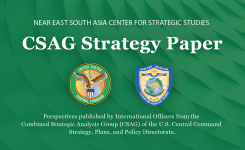- Near East South Asia Center for Strategic Studies
- CSAG Strategy Paper: Weaponizing the Belt and R...
CSAG Strategy Paper: Weaponizing the Belt and Road Initiative

Overview:
In October 2012, Professor Wang Jisi was the first Chinese scholar to speak about the need for China to revitalize the three Silk Roads to Southeast Asia, South Asia, and Central Asia. One year later, China’s “One Belt, One Road” initiative became prominent. President Xi Jinping, in a September 2013 speech at Kazakhstan’s Nazarbayev University, called for reviving the ancient “Silk Road” by establishing the “Silk Road Economic Belt”. On October 10, 2013, Premier Li Keqiang spoke about the new “Maritime Silk Road” at the 16th ASEAN-China Summit in Brunei. Finally, on March 28, 2015, the National Development and Reform Commission, the Ministry of Foreign Affairs, and the Ministry of Commerce published the first document, “Vision and Actions on Jointly Building Silk Road Economic Belt and 21st Century Maritime Silk Road”.
Thus, within three years of the idea’s emergence, the economic breakthrough that is mainly known as the “Belt and Road Initiative” (BRI) to increase China’s global economic connections began. (The term “belt” constitutes the land route of the project, which includes highways, railways, oil and natural gas pipelines, and infrastructure investments. The term “road” consists of the sea routes covered by the project.)
It is entirely plausible that China, the world’s largest exporter, would like to guarantee and diversify its trade routes while also looking to reach new energy sources safely. And in doing so, China recognizes the need to protect such a significant investment. We already know that China wants to be the world’s superpower by 2049, the 100th anniversary of the Chinese Communist Party. However, intermediate objectives are also ready in a timeline until the main goal is reached.
Accordingly, the first aim is to become the dominant power in ten leading technologies by 2023. Then it comes, before fully modernizing the People’s Liberation Army (PLA) by 2035, to modernize the PLA’s capabilities to be networked into a system of systems for ‘intelligentized warfare’ by 2027. Socialist modernization is another intermediate objective under the China Vision 2035 – to become a strong and technologically advanced country that is a global leader in innovation and new forms of industrialization. And finally, by 2049, transforming the PLA into a “world-class” military to build a modern socialist country that is prosperous, strong, democratic, culturally advanced, and harmonious.
This document, in accordance with the timeframe and the legal framework China has followed, refers to military-civilian cohesion in terms of the dual use of ports and merchant navy. Also, the document talks about how China can use all of this to its advantage and will try to scrutinize its effects on the United States.
Key Points:
- It is entirely plausible that China, the world’s largest exporter, would like to guarantee and diversify its trade routes while also looking to reach new energy sources safely.
- Since the announcement of the BRI in 2013, the Communist Party of China has been making the necessary legal arrangements to achieve its goals.
- China wants to legitimize using military force to defend the PRC’s economic interests abroad.
- Dual use is a leitmotif of Chinese economic expansion, including the BRI.
- While operating the Port of Haifa, China could use coercion to force Israel to support Chinese raison d’etre under a threat of slowing the sea deliveries or diverting Chinese shipping.
- The Port of Gwadar will not inevitably become a PLAN base; however, China is gaining foreign policy leverage over India.
- The problem presented by China’s “weaponization” of the BRI is not primarily a military one, and its solution can’t be primarily military either.
- The intensity of China’s efforts on civil-military integration makes them visible to some extent. Nonetheless, these efforts should be carefully monitored and timely action taken.
This strategy paper is a deep-dive analysis into the subject covered in a shorter information paper published 9 November 2022
View other USCENTCOM Combined Strategic Analysis Group (CSAG) papers here
The opinions and conclusions expressed herein are those of a number of international officers within the Combined Strategic Analysis Group (CSAG) and do not necessarily reflect the views of United States Central Command, not of the nations represented within the CSAG or any other governmental agency.


